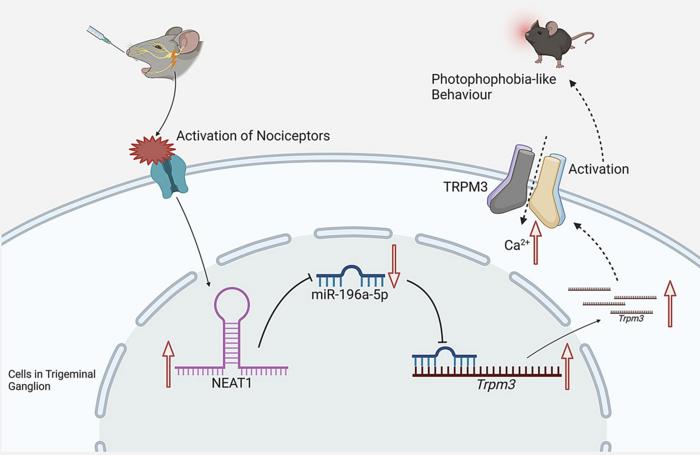In a groundbreaking study that could reshape how we understand migraine-related symptoms, an international team of scientists from the United Kingdom, Australia, and China has unveiled a critical molecular mechanism behind photophobia—the debilitating sensitivity to light experienced by many migraine sufferers. Central to their discovery is NEAT1, a long noncoding RNA molecule, which appears to orchestrate a cascade of genetic interactions culminating in heightened nerve sensitivity. This novel insight paves the way for targeted therapeutic approaches to a symptom that has long frustrated patients and clinicians alike.
Migraines afflict nearly one billion people worldwide, and photophobia is among the most common, yet least understood, symptoms accompanying these episodes. Unlike the throbbing pain that defines migraine, the underlying biology of light sensitivity has remained elusive. By focusing on NEAT1, the research team has shed light on the molecular underpinnings that translate cellular activity into the agonizing experience of light-induced discomfort. Published in The Journal of Headache and Pain, their findings provide a comprehensive look at how NEAT1 modulates neuronal signaling pathways during migraine attacks.
NEAT1 belongs to a vast class of long noncoding RNAs (lncRNAs), molecules that, while not coding for proteins, are increasingly recognized for their regulatory roles in gene expression and cellular metabolism. Unlike messenger RNAs, lncRNAs act as modulators that influence which genes are turned on or off, often in response to stress or inflammatory signals. Prior studies have implicated NEAT1 in neuroinflammation and cellular stress reactions, but its specific contribution to migraine pathophysiology had remained unexplored until now.
To elucidate NEAT1’s role, researchers utilized a sophisticated animal model wherein light sensitivity was chemically induced in mice, mimicking the photophobic response seen in migraineurs. Their investigative focus targeted the trigeminal ganglion, a neural hub intimately involved in transmitting migraine pain signals and processing sensory information from the face and head region. Through careful analysis, the team observed a significant upregulation of NEAT1 expression during induced photophobia, suggesting a direct involvement in this symptom.
Strikingly, when the expression of NEAT1 was experimentally reduced, the mice exhibited a marked decrease in light sensitivity, demonstrating a causal relationship. This modulation was not a mere side effect but pointed to NEAT1’s active participation in amplifying nerve responses under migraine-like conditions. Zhuoan Huang, the study’s first author and a PhD candidate at Xi’an Jiaotong-Liverpool University and the University of Liverpool, emphasizes that such findings “directly implicate NEAT1 as a driver of photophobia, rather than a passive marker of neural activity.”
Delving deeper into the molecular mechanics, the researchers uncovered that NEAT1 exerts its effects by interacting with miR-196a-5p, a microRNA known to regulate gene expression post-transcriptionally. MicroRNAs like miR-196a-5p typically serve as inhibitors, fine-tuning protein levels by destabilizing target mRNA or suppressing its translation. Under normal circumstances, miR-196a-5p restrains the gene Trpm3, which encodes the TRPM3 protein—a calcium-permeable ion channel involved in nociceptive signaling and neuronal excitability related to pain perception.
NEAT1 appears to act as a molecular sponge, sequestering miR-196a-5p and preventing it from suppressing Trpm3 expression. This sequestration leads to an overabundance of TRPM3 channels on neurons, causing them to become hyper-responsive to stimuli, such as light exposure. The enhanced nerve excitability correlates closely with the experience of photophobia, linking gene regulation intricately to symptom manifestation. As Huang summarizes, “NEAT1 disrupts the delicate molecular balance that normally keeps nerve sensitivity in check, turning up the gain on pain signaling pathways.”
The implications of this discovery extend beyond just photophobia. By clarifying how lncRNAs such as NEAT1 influence microRNAs and downstream gene expression, this research adds a vital piece to the puzzle of migraine pathology, which is notoriously multifactorial and complex. It also exemplifies the burgeoning importance of noncoding RNA research in neuroscience and pain medicine, where traditional protein-centric approaches have often fallen short.
It is important to note that this study was conducted exclusively on male mice, while migraines disproportionately affect women. Consequently, the applicability of these findings across sexes and in human patients remains to be fully validated. Future studies are essential to investigate sex-specific differences and to translate these molecular insights into clinical interventions for diverse patient populations.
Nonetheless, the potential to modify photophobia at its molecular root offers hope for millions of migraineurs trapped in cycles of recurring, debilitating pain and light sensitivity. By targeting NEAT1 or its downstream effectors, new classes of drugs could emerge, turning what was once an uncontrollable symptom into a manageable one. This research exemplifies the power of molecular biology to unravel enigmas of human health and disease.
In summary, the identification of NEAT1 as a critical modulator in the development of migraine-related light sensitivity marks a monumental advance in headache research. The demonstrated interplay between a long noncoding RNA, a microRNA, and an ion channel gene delineates a novel regulatory network contributing to the neural basis of photophobia. Such discoveries not only deepen scientific understanding but also propel the quest for innovative treatments that could dramatically improve the quality of life for those afflicted by migraines worldwide.
Subject of Research: Animals
Article Title: Nuclear paraspeckle assembly transcript 1 promotes photophobia behavior in mice via miR-196a-5p/Trpm3 coupling
News Publication Date: 22-May-2025
Web References:
https://doi.org/10.1186/s10194-025-02057-5
References: Huang et al., The Journal of Headache and Pain, DOI 10.1186/s10194-025-02057-5
Image Credits: Huang et al., DOI 10.1186/s10194-025-02057-5
Keywords: migraine, photophobia, NEAT1, long noncoding RNA, microRNA, miR-196a-5p, TRPM3, trigeminal ganglion, nerve sensitivity, pain signaling, gene regulation, neuroinflammation
Tags: breakthrough discoveries in migraine treatmentgenetic interactions in migraine attacksinternational migraine researchlight sensitivity in migraine suffererslncRNAs and gene regulationmigraine-related symptomsmolecular mechanisms of migrainesNEAT1 long noncoding RNAneuronal signaling pathways in photophobiaphotophobia in migrainestargeted therapeutic approaches for migrainesunderstanding migraine biology





